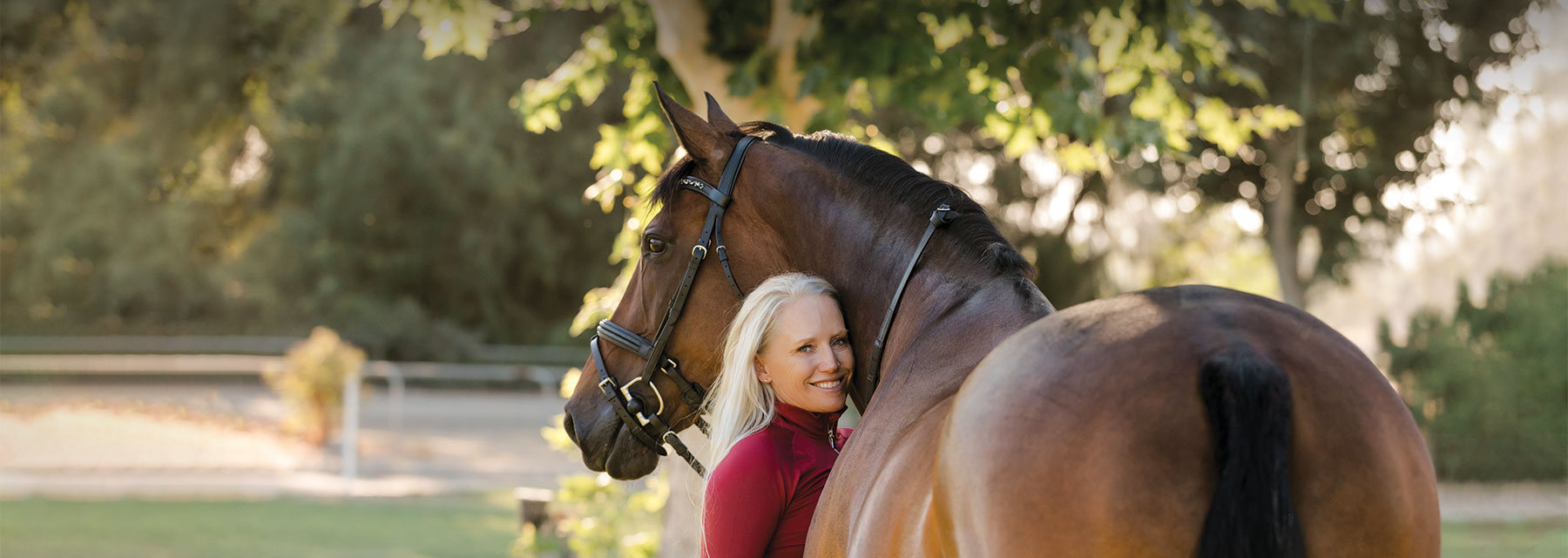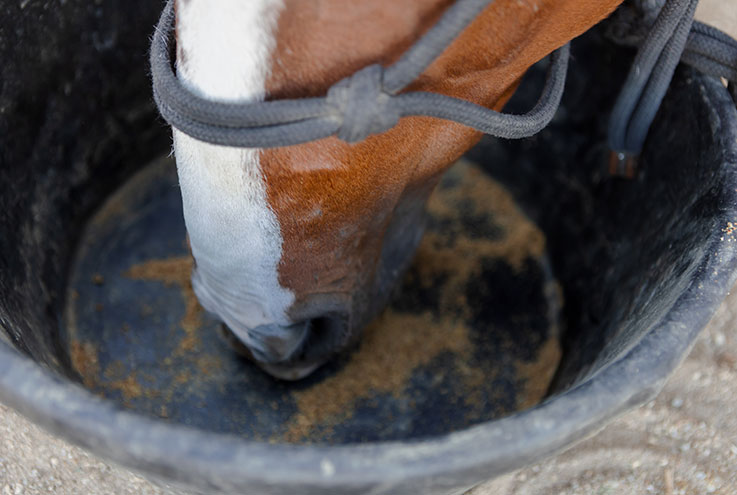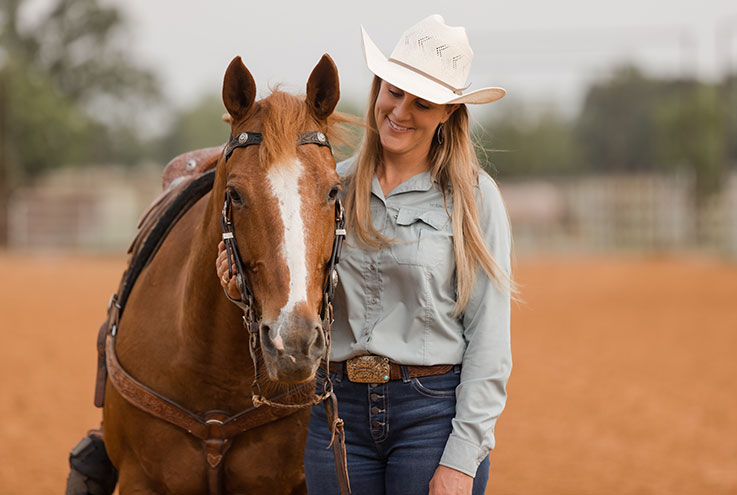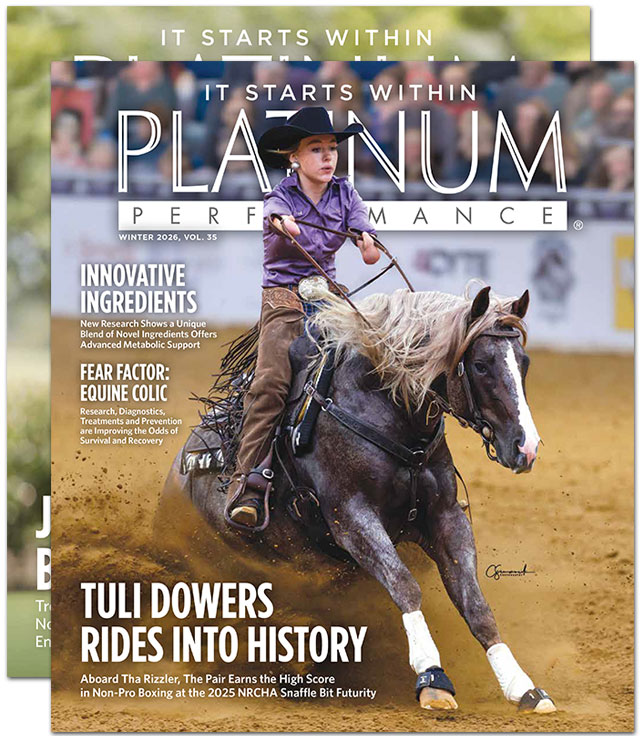Learn How Modifying a Horse’s Diet and Supplementation Can Support Health and Activity
Moving a horse into the active senior classification is not simply based on the age of the horse but also on the physiological status and physical signs of aging. Individual horses age uniquely, and the actual age when a mature horse crosses the senior threshold can be subjective. Some horses that have trained extensively while they were young may have seemingly “old” joints and athletic injuries as 5-year-olds. Conversely, it is now quite common to see horses in their 20s still actively competing with no signs of slowing down.
Aging horses comprise an increasing proportion of horses in developing countries. Three in 10 horses in the United Kingdom are 15 years or older, and a 2015 survey from the National Animal Health Monitoring System determined that approximately 11.4% of horses in the United States are over 20 years of age. Horses over 20 are generally defined as aged, and this is often the age when physiological function may start to decline. A current willingness and dedication by care takers to maintain older horses is changing the public perception about the longevity of horses with the increased realization that senior equids can continue to live healthy and athletically active lives longer than ever before.
Due to advances in veterinary diagnostics, therapy and improved nutrition, senior equine athletes are thriving, with many horses competing well into their late teens and 20s. Routine veterinary care, important for all horses, is imperative for maintaining the health of an aging athlete. A veterinarian will ensure a regular vaccination schedule, assess a horse’s body condition and systemic health and will also help to monitor any pain or discomfort. Regular blood work with a complete blood count and serum biochemistry profile is important in identifying any early signs of disease. In suspect cases, a senior horse’s endocrine status can be checked for metabolic health and for the development of pituitary pars intermedia dysfunction (PPID or equine Cushing’s disease), which has an increased prevalence in older horses regardless of activity level. Routine dental care is critical to maintaining the ability to chew and digest feeds. Veterinarians will maintain a regular deworming schedule and may suggest fecal tests to determine the most appropriate deworming schedule for an individual horse.
Genetics play a significant role in the aging process, and some older horses in good health and body condition may not require significant alterations in their management from their younger years, diet included. However, as they age, many senior horses benefit from some dietary adjustments that support changing dentition, digestive efficiency and immune health. The ideal types of feed remain mostly the same, but the animal’s ability to chew, digest and absorb foods may change. Energy, protein, vitamin and mineral requirements remain consistent as horses age; however, diet can often be optimized by tailoring the daily feeding with specific nutrients to support an active senior horse.
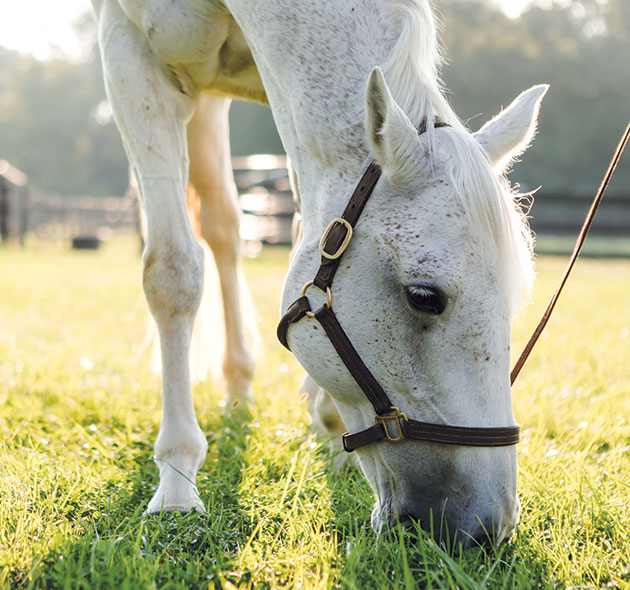
Step 1: Forage
Nutrition is important for every athlete to have the energy and fitness for their sport. As grazing herbivores, a fiber-rich diet is essential to the health and wellness of every horse. Long-stem fiber from forage, including pasture grasses and hays helps to promote intestinal motility and supplies most major nutrients that a horse needs daily. Forage also requires more chewing and salivation, helping to moisten feed and buffer acid produced in the stomach. Saliva and salivary enzyme production may lessen with age, diminishing their ability to properly digest nutrients. Saliva contains the amylase enzyme, which starts the digestion of starches. If salivary enzymes are not produced in adequate levels, carbohydrates (starch and sugar) may not be digested properly in the foregut, depriving the horse of the full nutrient content of the feed, including a reduction in calories, amino acids, fats and vitamins necessary to maintain health and to build and repair tissues. Additionally, there is a risk that undigested starch and sugar from the foregut entering the hindgut will disrupt the pH and alter the intestinal microbes and potentially lead to hindgut acidosis, colic, endotoxemia and laminitis. A lack of saliva can also result in less chewing. This change can be mitigated by simply moistening a horse’s feed with water or wetting hay to increase the ease of chewing. This supplemental water in soaked feeds can increase both feed and water intake. Most anything fed to a senior horse — hay cubes, hay pellets, beet pulp and commercial senior feeds — can be soaked and served.
Maintaining body condition is a common issue as athletes age, with many horses requiring more calories than when they were younger. Once dentition issues and systemic diseases are ruled out, the focus of managing weight in a senior athlete can focus on the diet and digestible feed to provide sufficient calories to support activity level. As the hindgut ages, it may lose some of its ability to ferment fiber resulting in older horses receiving less nourishment from forage intake and requiring higher-quality forages. Senior horses often benefit from general diets that include a highly digestible forage with an acid detergent fiber (ADF) concentration of less than 40% and a lignin concentration of under 9%, on a dietary dry matter basis. If a horse that has always maintained body condition on a consistent diet begins to drop weight, consider more digestible fiber options. Adding a softer, leafier hay, such as an immature cutting of grass hay or alfalfa, to the diet can replace mature, stemmy and tougher cuttings of hay as needed. Younger forages are easier to chew, which then improves the availability of nutrients during digestion. Mixing different types of forages can offer a more complete and beneficial blend of amino acids and other nutrients as well. Horses generally need to consume 2% of their total body weight daily in combined feeds. Forage sources should be fed at a rate of at least 1-1.5% of the body weight per day. Forage rates should be increased to support weight gain or to help maintain weight in harder keeping horses.
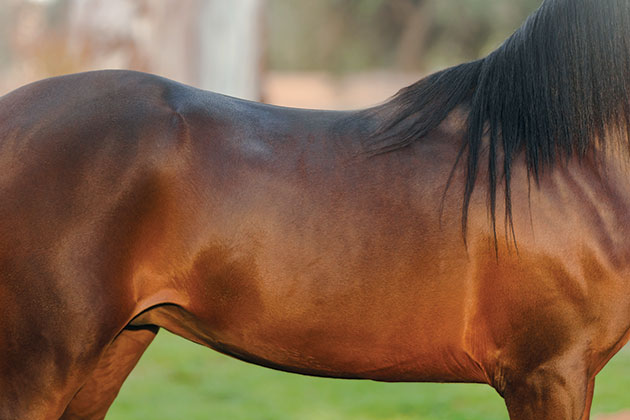
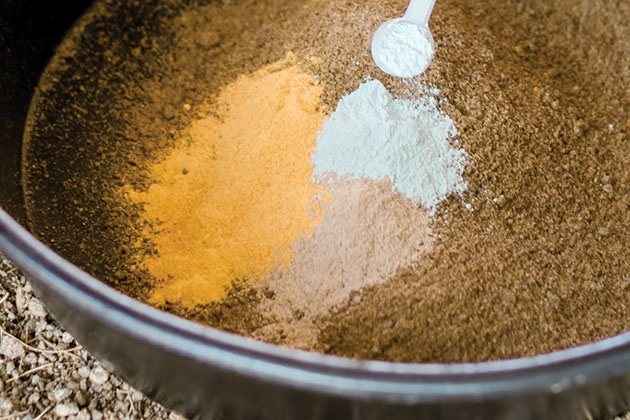
Step 2: Balance
All horses have essential dietary requirements for good health that include a balanced menu of energy (calories), fiber, amino acids (protein), vitamins, minerals and water. Equine athletes on a predominately- forage diet may need a balance of overall calories with specific vitamins and minerals. To balance a hay-only diet or for horses that do not require excess calories, consider a comprehensive supplement or commercial balancer that supplies high-quality amino acids, trace minerals, vitamins and omega-3 fatty acids to complement the diet and keep calories minimal.
For horses requiring more calories to maintain weight than what hay alone provides, there are several healthy dietary options to increase energy, including concentrated feeds and oils. Soaked beet pulp pellets and shreds are high in fiber, easy to chew and deliver more calories per pound than regular hay. Adding bran to straight beet pulp can increase calories and help balance major minerals, particularly with an alfalfa-based diet. A commercial complete feed can also be incorporated into the diet of a senior athlete to provide calories, protein, vitamins and minerals. Healthy oils, such as flaxseed, provide beneficial omega-3 fats that can be top-dressed onto most feeds and provide another easy boost of calories in the diet of a working senior.
The quality and digestibility of dietary protein is important in forage and other feeds. Quality refers to a protein’s amino acid profile, with lysine often being the rate-limiting amino acid or the amino acid most likely to fall short. Ration balancer products and commercial complete feeds often provide a high-quality and balanced source of protein to meet a senior athlete’s requirements. Supplementing lysine and threonine can help maintain muscle mass and topline. Horses should always be provided with a source of plain, white salt as well as fresh, clean water. Any feed changes should be made slowly over seven to 10 days to allow the hindgut microbial population to adjust to new foods.
The Easy Keeping Senior Athlete
Active horses that are gaining weight more easily than they had previously may have a slowed metabolism or alterations in their hormonal balance. Easy keeping athletes can thrive on a forage-only diet that is combined with a balanced vitamin, mineral, antioxidant and omega-3 fatty acid wellness supplement. When hay comprises the majority, or entirety, of the diet, hay testing may be advisable.
For active horses that have Cushing’s disease or equine metabolic syndrome, it is recommended to provide feeds with a lower concentration of non-structural carbohydrates (NSC, starch and sugar content) as the basis of the diet, including hays and other feeds. Slow feeder devices or smallhole hay nets can allow a horse to have access to necessary forage throughout the day and emulate a grazing scenario. Low-NSC grass hay and a comprehensive wellness supplement or use of a ration balancer provides a good, basic diet for an overweight senior athlete.
Weight loss can be achieved by feeding a slightly calorie-restricted diet that is designed under the guidance of a veterinarian.
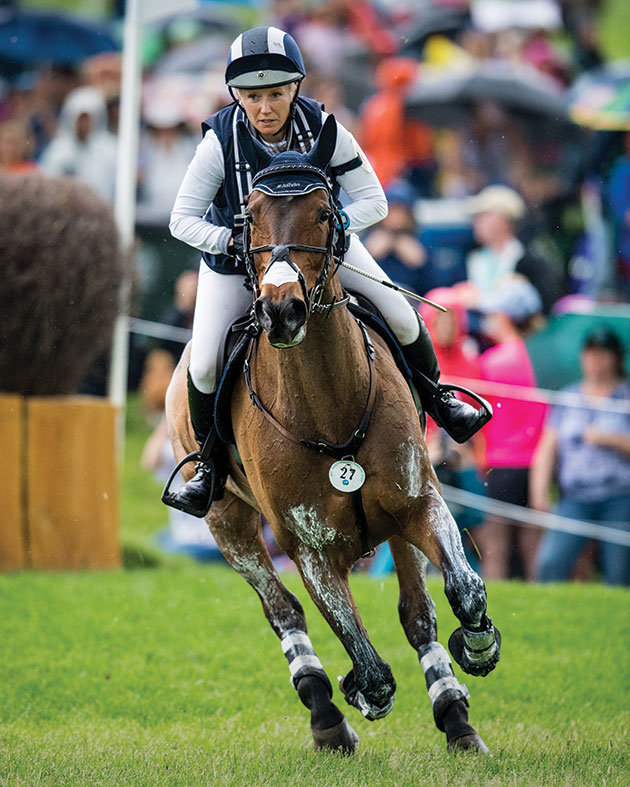
Hawley Bennett-Awad currently competes on her 20-year old mare, Jollybo, in FEI CCI5* events.
PHOTO BY SHANNON BRINKMAN
Hawley Bennett-Awad currently competes on her 20-year old mare, Jollybo, in FEI CCI5* events.
PHOTO BY SHANNON BRINKMAN
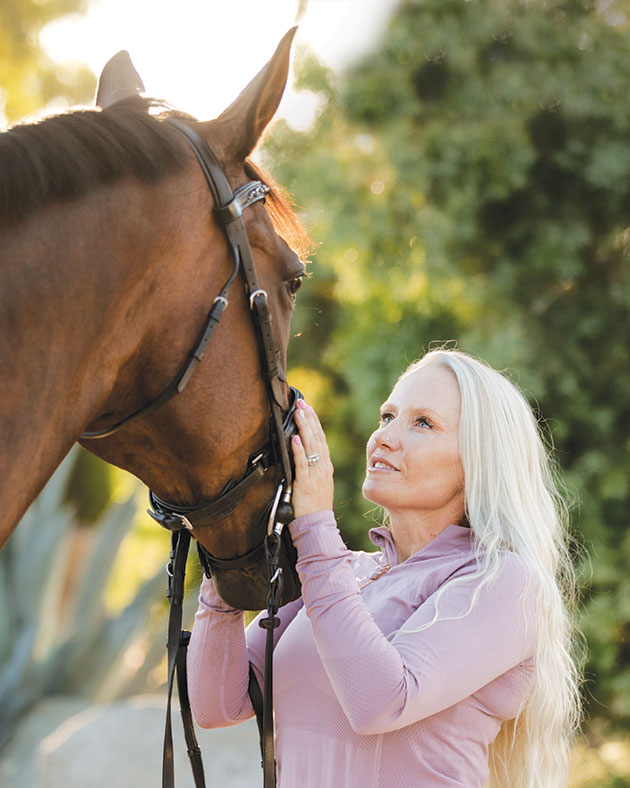
Nutrition has heightened importance for the competitive senior horse as they have health nuances that may require specific support that were unnecessary at a younger age. This tailored nutrition can keep a senior equine active, and supplementation can make the difference in the longevity of an athletic career.
Nutrition has heightened importance for the competitive senior horse as they have health nuances that may require specific support that were unnecessary at a younger age. This tailored nutrition can keep a senior equine active, and supplementation can make the difference in the longevity of an athletic career.
Step 3: Support
Nutrition has heightened importance for the competitive senior horse as they have health nuances that may require specific support that were unnecessary at a younger age. This tailored nutrition can keep a senior equine active, and supplementation can make the difference in the longevity of an athletic career.
Prebiotics and Probiotics
Senior athletes may benefit from supplementary pre- and probiotics to support digestive efficiency and immune health. Prebiotics and probiotics can increase nutritional efficiency and help produce and maintain the beneficial bacteria needed for proper fiber digestion and fermentative efficiency, as yeasts have been shown to improve mineral absorption.
Prebiotics are substrates selectively utilized by host microorganisms conferring a health benefit that aids in the growth, survival and function of beneficial intestinal microflora by acting as a direct nutrient source for the microbes. Enhanced function of the intestinal microbes improves digestive efficiency. For example, Aspergillus oryzae fermentation products promote gut health by enhancing fiber breakdown. This increases the bioavailability of fiber for fiber-digesting microbes in the hindgut that is critical in hindgut-fermenting horses that acquire a large portion of their energy requirements from dietary fiber fermentation. As a prebiotic, the fermentation products of A. oryzae selectively enhance the activity of the desirable bacteria in the gut. Probiotics are viable, live microorganisms that provide a health benefit to the horse beyond their nutritive value. Saccharomyces cerevisiae is a yeast species that optimizes starch and fiber utilization. In horses, the documented benefits of S. cerevisiae include improved microbial activity, nutrient digestibility and feed efficiency. Supplementation with S. cerevisiae and the related S. boulardii may help maintain normal pH in the cecum and colon when horses are fed high starch diets. With more than 70% of the immune system residing in the digestive tract, supplementing with pre- and probiotics can be advantageous to the aging athlete, especially if the horse extensively travels.
Omega-3 Fatty Acids
Active senior horses will benefit from supplemental omega-3 fatty acids in the diet, particularly those on a hay-only diet or that do not have consistent access to pasture grass. Unable to be produced internally by the horse, these specialized polyunsaturated fats must be consumed daily. Omega-3 fatty acids are found in elevated concentrations in fresh pasture grass, flaxseed, fish oil and some marine algae sources. Their well-documented benefits offer a multitude of systemic health advantages, including support for immune, cardiac, joint and metabolic health.
Antioxidants
Free radical accumulation may be closely involved in aging and age-related health conditions. Oxidative stress and damage caused by reactive oxygen species, or free radicals, have been implicated in many health disorders in horses. Radical oxygen species promote the degradation of joint components, including the synovial fluid and surrounding cartilage. This joint damage may be counteracted by antioxidants, such as vitamins C and E. Vitamin C is a critical component of cartilage health, and its well-known antioxidant effects may protect against oxidative damage in the joint. Vitamin C is important for maintaining immune function as well as being a natural antihistamine and may be useful for seasonal respiratory or skin allergies. Supplementation with vitamin C can enhance the body’s antibody response to vaccines and can support immune health, particularly while traveling and competing. Vitamin C is typically manufactured at adequate levels in the liver of the adult horse, but as they age, horses are less able to manufacture vitamin C due to a decline in hindgut microflora or decreased liver function. Blood vitamin C levels have been demonstrated to be lower in older horses who may benefit from supplemental vitamin C as their bodies may be less able to synthesize adequate production levels.
Supplementation with natural vitamin E (d-alpha tocopherol) is recommended for senior athletes as it provides potent antioxidant benefits for many health areas of concern including immune, muscular, vascular and neurological support. Vitamin E also reduces measures of oxidative activity correlated with airway concerns. Research suggests that supplemental vitamin E may support the immune system of older horses, particularly important for traveling athletes. Vitamin E is plentiful in fresh, green grass but will likely require supplementation for horses on a hay-only diet or without consistent access to fresh grass.
Joint Nutrients
A main goal for aging athletic joints is to maintain comfort and to treat small issues before becoming big issues. Joint concerns, including stiffness and discomfort, often develop during the natural aging process. Joint issues are commonly thought of as being in the legs, but the same care and attention should be paid to the neck, shoulders, back and hip joints, especially for equine athletes.
Dietary nutrients may provide support for occasional stiffness and discomfort in older equines. Omega-3 fatty acids, antioxidants and cartilage-building nutrients help support joint function as horses age. Research suggests that omega-3 fatty acids have a supportive role in joint health. Antioxidants, such as vitamin C, manganese and zinc, may also play a role in mitigating the oxidative stress and damage caused by free radicals. The common joint-supporting nutrient glucosamine is a precursor of glycosaminoglycans, such as chondroitin sulfate and hyaluronan, which naturally occur in the joint capsule and form the extracellular matrix of cartilage. Hyaluronic acid is a key component of the synovial fluid that nourishes, lubricates and protects the joints. Studies have shown oral hyaluronic acid to be bioavailable. In horses, Avocado/Soy Unsaponifiables (ASU) has demonstrated an ability to promote the synthesis of glycosaminoglycans and support normal cartilage.
Along with proper farrier and veterinary work, consistent turnout encourages low-impact movement that is highly beneficial for aging joints and soft tissue. Adequate warm-up and cool down time is necessary for exercising seniors supporting joint and muscle well-being.
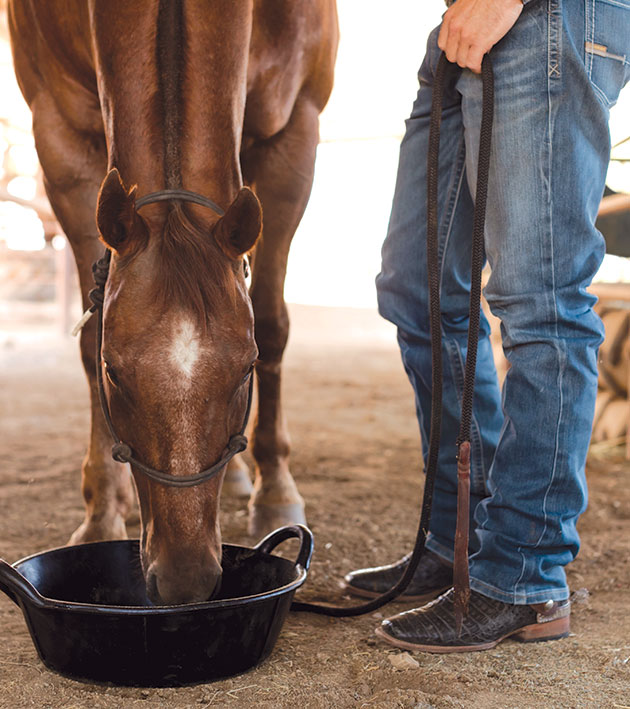
Time for a Diet Refresh?
Watch for These Signs:
- Weight Fluctuation
- Loss of topline or general muscle mass
- Sway back appearance
- Poor coat or hoof quality
- Dentition issues
- Metabolic or joint changes
Typical Attributes of an Active Senior Commercial Feed
- Highly palatable
- Easy to chew
- Readily digestible fiber
- Nutrient dense
- Moderate to high calories
- Fiber rich
- Added fat
- Lower sugar and starch content
- Quality protein sources/balanced amino acids
- Increased minerals, including phosphorus, copper and zinc
- Vitamins and antioxidants for immune support
- Gastric support
Turn-Out Time
Turning out your senior may be one of the most important management tips for keeping horses healthy and competitive. Simple walking can ease muscle stiffness and keep joints and soft tissue supple. Consistent, low-impact movement can help seniors stay limber and ready to work, as well as mentally fresh. Horses with access to pasture turnout are typically less stressed, less prone to gastric ulcers and colic and less likely to suffer from soft tissue injuries. It can also prevent loss of muscle mass, particularly important for senior athletes that may require a longer amount of time to regain fitness and conditioning. Pasture also offers many nutritional benefits and can help to keep weight on hard keepers. If turning out is not available, such as at many competitions, hand grazing horses for 30-minute sessions multiple times a day also provides many benefits.
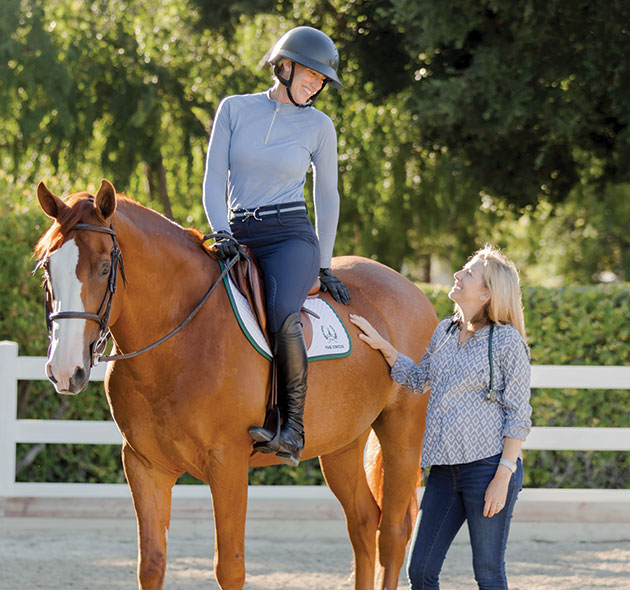
Dietary adjustments and targeted supplementation can support health issues commonly seen in older athletes, including fluctuations in body weight, a diminished muscle mass, digestive inefficiencies and joint stiffness.
Dietary adjustments and targeted supplementation can support health issues commonly seen in older athletes, including fluctuations in body weight, a diminished muscle mass, digestive inefficiencies and joint stiffness.
In Summary
Common changes seen in older athletes include fluctuations in body weight that manifest as a loss of body condition or with obesity, a diminished muscle mass especially notable along the topline, digestive or absorptive inefficiencies and joint stiffness. Dietary adjustments and targeted supplementation can support these health issues.
Feeding modifications that support fiber digestion and maximize digestive efficiency may be all that a senior horse needs to remain healthy and active. Older equine athletes should continue to get most, if not all, of their calories from quality forage in the form of pasture or hay as long as they are able to chew and maintain an appropriate body weight. Balance a forage-based diet as needed with calories from healthy oils and digestible, fiber-rich concentrates to support body condition.
A comprehensive omega-3 fatty acid, amino acid, antioxidant, vitamin and trace mineral supplement or commercial active senior feed that complements a forage diet can help active seniors meet nutrient requirements. Lastly, support the athlete with nutrients tailored for the individual horse. Supplementation may be centered around wellness and immune health, digestive efficiency and physical comfort, allowing senior horses to continue being athletic partners and doing what they love for years to come.
